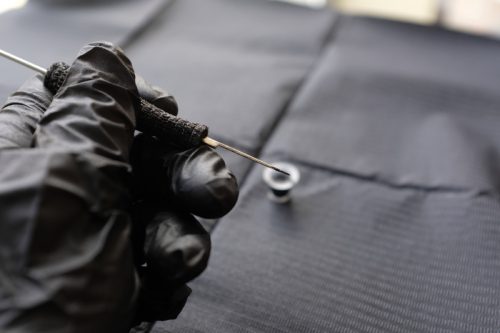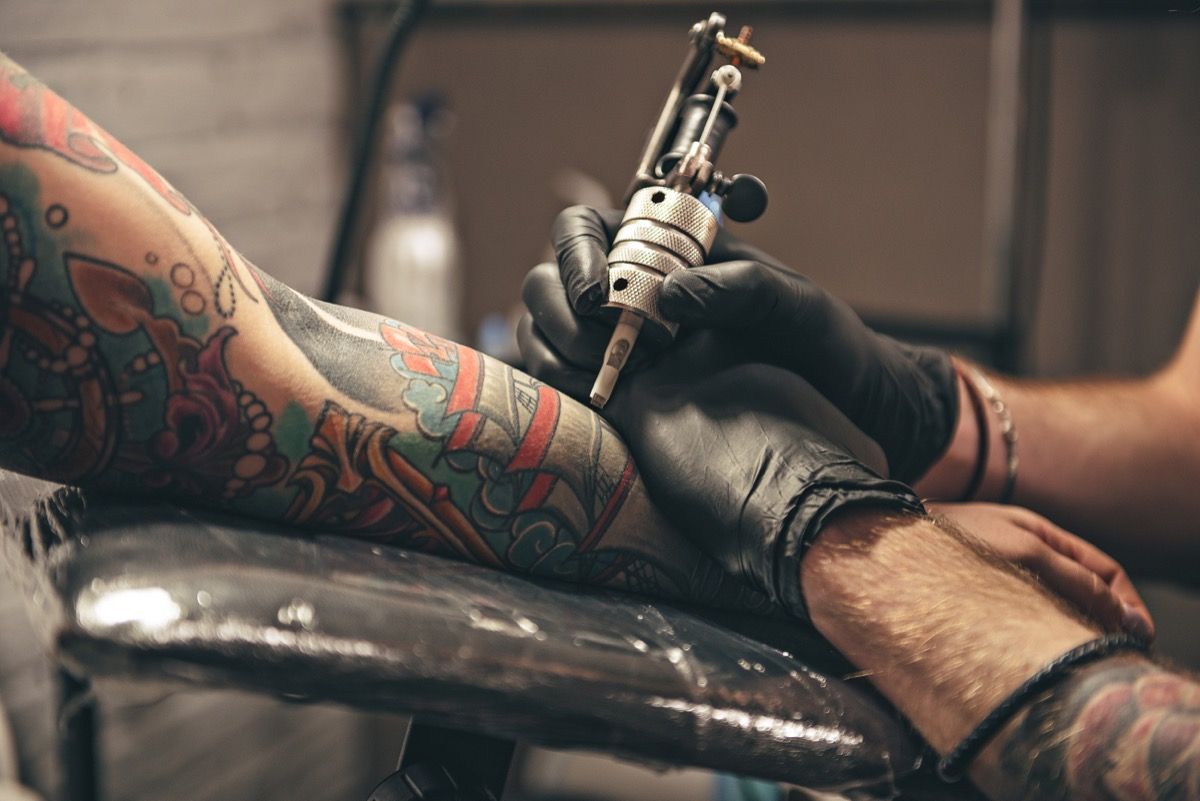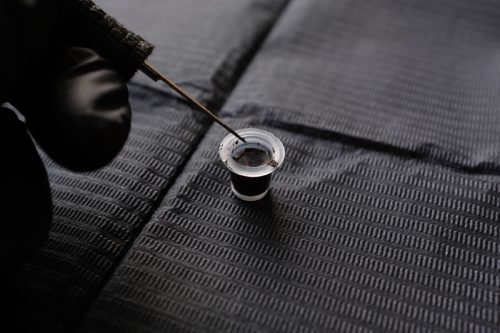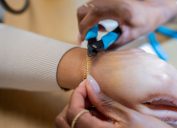What Are Stick-and-Poke Tattoos?
Discover how this unique non-electric tattoo technique works.

Thinking about getting some new ink? Getting a tattoo is something people have done for centuries, and it remains a fun (albeit permanent) way to express your individuality. But there are options outside of the machine tattoos you might be more familiar with. Stick-and-poke tattoos are a unique strain of tattooing, rich with history that can be tied to several different cultures.
So, if you've been mulling over the idea of getting tatted, explore why a stick-and-poke tattoo might be the right variety for you. Discover how it works, aftercare tips, and whether it's anything like getting a regular tattoo.
RELATED: 6 Popular Tattoos That Have Secret Meanings You Never Knew.
What Are Stick-And-Poke Tattoos?

Stick-and-poke tattoos, also known as hand-poke tattoos, are the oldest form of tattooing. While a regular tattoo uses an electric motor that quickly moves the needle up and down across your skin, the stick-and-poke technique ditches the buzzing electric device. By hand, artists apply the ink under your skin using a pencil-like tool or tattoo needle, lightly stabbing the skin repeatedly to create the desired image.
"A needle attached to a simple handle (like a pencil) is used to poke ink into the skin one dot at a time," says Master Svietliy, a philosophy and meditation teacher and sacred symbolism artist. "This technique requires a steady hand and can create delicate, detailed designs. It's believed to have roots in ancient practices across various cultures, though it has become widely popular worldwide due to its simplicity and the minimal equipment required."
The stick-and-poke tattoo technique can be traced back to ancient Egypt, where evidence of this practice has been observed on mummified people. One woman buried more than 3,000 years ago was found with lotus blossoms drawn on her hips, cows on her arms, and baboons on her neck.
Despite being a common practice throughout history, the stick-and-poke technique has made its mark in modern society as well. It became popular in punk culture, as tattoos were viewed as anti-authority. Many tattoo artists still practice this delicate art, and stick-and-poke kits are also sold online.
RELATED: 6 Popular Tattoos You Should Never Get, Experts Say.
Are There Different Types of Stick-and-Poke Tattoo Techniques?

The stick-and-poke technique is practiced around the globe within many different cultures, but not everyone does it exactly the same.
Long Rod and Bamboo Tattooing
This technique originated in Southeast Asia and uses a long, sharp-edged bamboo stick or metal rod.
"It's often used to perform sacred Sak Yant tattoos, which are believed to provide protection and blessings to the wearer," Svietliy says. "The artist taps on the handle end of the rod with a mallet to puncture the skin and insert the ink, a method that requires great skill and patience."
Japanese Tebori
In this Japanese technique, artists use a nomi, which is like a chisel attached to a handle.
"The artist uses hand motion to carve the ink into the skin, allowing for nuanced gradients and subtle shading that are often difficult to achieve with machines," Svietliy says. "Tebori tattoos are cherished for their artistry and the tactile connection they foster between the artist and the client."
RELATED: The Tattoo You Should Get, Based on Your Zodiac Sign.
Batok (Ta-tau)
This technique hails from traditional Australasian indigenous communities and Pacific Islanders. An L-shaped tool dipped in ink is tapped into the skin with a mallet at a 90-degree angle, Svietliy explains.
"[This] requires rhythmic precision and results in distinctive patterns that are integral to the cultural identity and rites of passage within these communities," Svietliy says.
Machine Tattoos vs. Stick-And-Poke Tattoos: What Is the Difference?

Both machine and stick-and-poke tattoos are permanent ways to mark your skin. However, if a stick-and-poke job is done poorly, that tattoo can fade away significantly over time.
In terms of how quickly each technique takes, the machine tattoo does a much faster job than the hand-poking technique, as each mark is individually made by the artist.
And when it comes to pain, it is always subjective and depends on the person. The stick-and-poke technique involves a series of pokes into the skin while an electric machine drags the needle and ink through your skin. Ultimately, it's a matter of which type of discomfort you prefer.
How Long Do Stick-And-Poke Tattoos Last?
Like regular tattoos, stick-and-poke tattoos can last a lifetime when done correctly. A common misconception about this technique is that because it is done by hand, these tattoos are less permanent, which is not necessarily true.
"When applied correctly by a skilled artist, these tattoos often retain their precision and clarity longer than machine tattoos," Svietliy says. "This is because a properly administered hand-poked tattoo minimizes skin trauma, avoiding the scarring that can cause ink to spread and blur over time."
Stick-and-poke tattoos, however, do tend to fade when done incorrectly. They may still be visible, but become much lighter over time.
Like machine tattoos, if you are looking to get rid of a stick-and-poke tattoo, laser removal is the most effective way to do so. According to the Medermis Laser Clinic, "Removal creams, dermabrasion, coconut oil, lemon, and other internet myths will not fade your ink. The only safe and effective way to remove your stick-and-poke tattoo is with laser removal."
Keep in mind, there are a few factors that may affect how quickly the laser removal works, including the type of ink colors used or pre-existing skin conditions.
RELATED: What Is Permanent Jewelry and Is It Right for Me?
Do Stick-And-Poke Tattoos Hurt?

We can all agree that having a needle go into your skin isn't a very pleasant experience, but when it comes to your stick-and-poke tattoo, different factors can impact your comfort level and overall experience.
For one thing, the level of pain depends on where you get your mark. According to Healthline, the legs, feet, neck area, and under the chest are the highest-pain areas for both men and women, while the arms are usually less distressing. Your experience can also depend on the artist.
"The pain level of getting a tattoo can vary significantly based on the artist's technique and the individual's pain threshold," Svietliy says. "With over 15 years of experience, I have refined a gentle and careful approach that reduces discomfort while maintaining the highest quality of artistry. The result is a tattoo experience that is as minimally painful as it is artistically fulfilling."
RELATED: Should I Get a Daith Piercing?
How Do You Take Care of a Stick and Poke Tattoo?

When getting a stick-and-poke tattoo, your skin becomes a pin cushion that is repeatedly punctured to impart the ink into your skin. This process can be slightly bloody and leave your skin raw and swollen, which is why tattoo aftercare is essential.
"The crucial healing period lasts about two weeks, during which sweating, submerging in water, and vigorous activity should be avoided to prevent infection and ensure optimal healing," Svietliy shares. "Continuous use of lotions and sunscreen can help maintain the tattoo's vibrancy."
According to Ink Nurse, post stick-and-poke tattoo be sure to:
- Cover your new tattoo(s) for as long as your artist recommends. This can vary based on the bandage used.
- After removing your bandage, gently wash your tattoos with lukewarm water.
- If your artist gave you any ointment or cleansers, use the suggested amount.
- Keep your tattoo out of direct sunlight for the first week, as the skin will be very sensitive.
RELATED: The Medusa Piercing: What It Means and What to Expect.
Are Stick-And-Poke Tattoos More Expensive?

Generally tattoos can be a very costly piece of work. Eva Karabudak, a celebrity tattoo artist, who has done work on Sam Smith, SZA and Joe Jonas, charges $600 an hour. Thankfully, not all artists are this pricey, but there are several factors that can cause these costs to climb.
The complexity of the design and how long it takes to complete the tattoo can impact pricing. A full-back tattoo can take 45 to 55 hours, and a full sleeve can cost anywhere between $2,000 and $6,000. Certain colors and the amount of shading used in your tattoo can also influence the cost, as well as the expertise of the artist.
"The cost of stick-and-poke tattoos varies based on the artist's skill level and reputation," Svietliy explains. "You may pay more for high-quality craftsmanship, but it is an investment in durable art. It's crucial to remember that lower costs often reflect inexperience and can result in subpar tattoos that do not age well."
The average artist charges about $150 an hour or more. You can also purchase a stick-and-poke tattoo kit for anywhere between $6 and $100. But be cautious, and don't be afraid to splurge on your tattoos: Stick-and-poke tattoos in particular are something you want to invest in, as the cost usually reflects the quality of the artist and their work.
RELATED: New Research Discovers Hidden "Harmful" Ingredients in Tattoos.
Are Stick and Poke Tattoos Safe?

Although stick-and-poke tattoos are incredibly accessible and seem like something just about anyone can do, it's best to leave it to the professionals… and not your buddy with a kit. Although a surface-level procedure, getting any type of tattoo requires a level of intrusion into the skin, so it should be handled with utmost cleanliness.
"Safety is paramount in tattooing, a practice that involves exposure to blood and body fluids and thus carries inherent risks," Svietliy says. "Throughout my years of global tattooing, I've seen alarming lapses in safety, from informal settings to professional parlors where artists neglect critical safety standards, leading to cross-contamination. To mitigate these risks, it's crucial to work with trained professionals who understand and implements rigorous safety protocols."
Although stick-and-poke tattoos are known for their DIY vibe, avoid letting your inexperienced but well-meaning pal practice their technique on you. To avoid putting yourself at risk of having an allergic reaction, a nasty skin infection, or transmitting bloodborne pathogens, you'll probably want to work with a professional. And seek immediate medical attention if you notice pus, excessive redness, pain, or swelling after a session.
Svietliy suggests picking your tattoo artist based on their "skill, style, and safety standards, not just accessibility."
RELATED: Divorce Rings: How to Repurpose Your Engagement and Wedding Jewelry.
Wrapping Up
If the whirr of a tattoo needle freaks you out, the stick-and-poke technique could be right for you. Getting a tattoo is exciting, and the stick-and-poke technique provides an even cooler way to get one, since it comes with a rich cultural history and requires undeniable skill. So, the next time you consider getting a tattoo, think about trying something a little more old-fashioned—but stylish in any era.





















